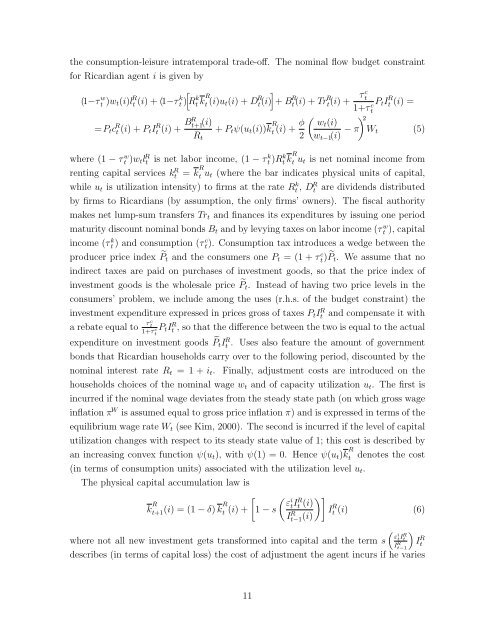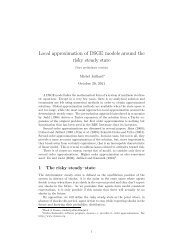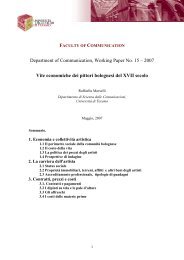The general equilibrium effects of fiscal policy
The general equilibrium effects of fiscal policy
The general equilibrium effects of fiscal policy
You also want an ePaper? Increase the reach of your titles
YUMPU automatically turns print PDFs into web optimized ePapers that Google loves.
the consumption-leisure intratemporal trade-<strong>of</strong>f. <strong>The</strong> nominal flow budget constraintfor Ricardian agent i is given by[](1−τ w t )w t (i)l R t (i) + (1−τ k t ) Rt k k R t (i)u t (i) + D R t(i) + B R t(i) + Tr R t(i) + τ c tP1+τ c t I R t (i) =t=P t c R t (i) + P t I R t (i) + BR t+1(i)+ P t ψ(u t (i))k R t (i) + φ ( ) 2 wt (i)R t 2 w t−1 (i) − π W t (5)where (1 − τ w t )w t l R t is net labor income, (1 − τ k t )Rt k k R t u t is net nominal income fromrenting capital services k R t = k R t u t (where the bar indicates physical units <strong>of</strong> capital,while u t is utilization intensity) to firms at the rate Rt k , D R t are dividends distributedby firms to Ricardians (by assumption, the only firms’ owners). <strong>The</strong> <strong>fiscal</strong> authoritymakes net lump-sum transfers Tr t and finances its expenditures by issuing one periodmaturity discount nominal bonds B t and by levying taxes on labor income (τ w t ), capitalincome (τ k t ) and consumption (τ c t). Consumption tax introduces a wedge between theproducer price index ˜P t and the consumers one P t = (1 + τ c t) ˜P t . We assume that noindirect taxes are paid on purchases <strong>of</strong> investment goods, so that the price index <strong>of</strong>investment goods is the wholesale price ˜P t . Instead <strong>of</strong> having two price levels in theconsumers’ problem, we include among the uses (r.h.s. <strong>of</strong> the budget constraint) theinvestment expenditure expressed in prices gross <strong>of</strong> taxes P t I R t and compensate it witha rebate equal toτ c tP1+τ c t I R t , so that the difference between the two is equal to the actualtexpenditure on investment goods ˜P t I R t . Uses also feature the amount <strong>of</strong> governmentbonds that Ricardian households carry over to the following period, discounted by thenominal interest rate R t = 1 + i t . Finally, adjustment costs are introduced on thehouseholds choices <strong>of</strong> the nominal wage w t and <strong>of</strong> capacity utilization u t . <strong>The</strong> first isincurred if the nominal wage deviates from the steady state path (on which gross wageinflation π W is assumed equal to gross price inflation π) and is expressed in terms <strong>of</strong> the<strong>equilibrium</strong> wage rate W t (see Kim, 2000). <strong>The</strong> second is incurred if the level <strong>of</strong> capitalutilization changes with respect to its steady state value <strong>of</strong> 1; this cost is described byan increasing convex function ψ(u t ), with ψ(1) = 0. Hence ψ(u t )k R t denotes the cost(in terms <strong>of</strong> consumption units) associated with the utilization level u t .<strong>The</strong> physical capital accumulation law is[ ( )]k R t+1(i) = (1 − δ) k R εit (i) + 1 − s t I R t (i)I RI R t (i) (6)t−1(i)( )ε iwhere not all new investment gets transformed into capital and the term s t I R tI R I R tt−1describes (in terms <strong>of</strong> capital loss) the cost <strong>of</strong> adjustment the agent incurs if he varies11





